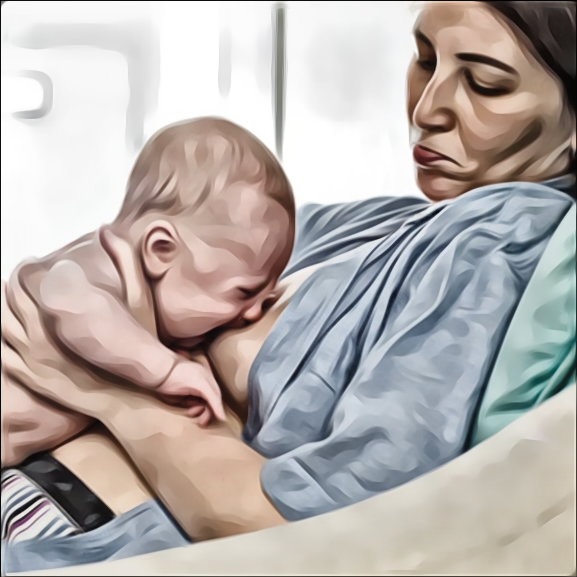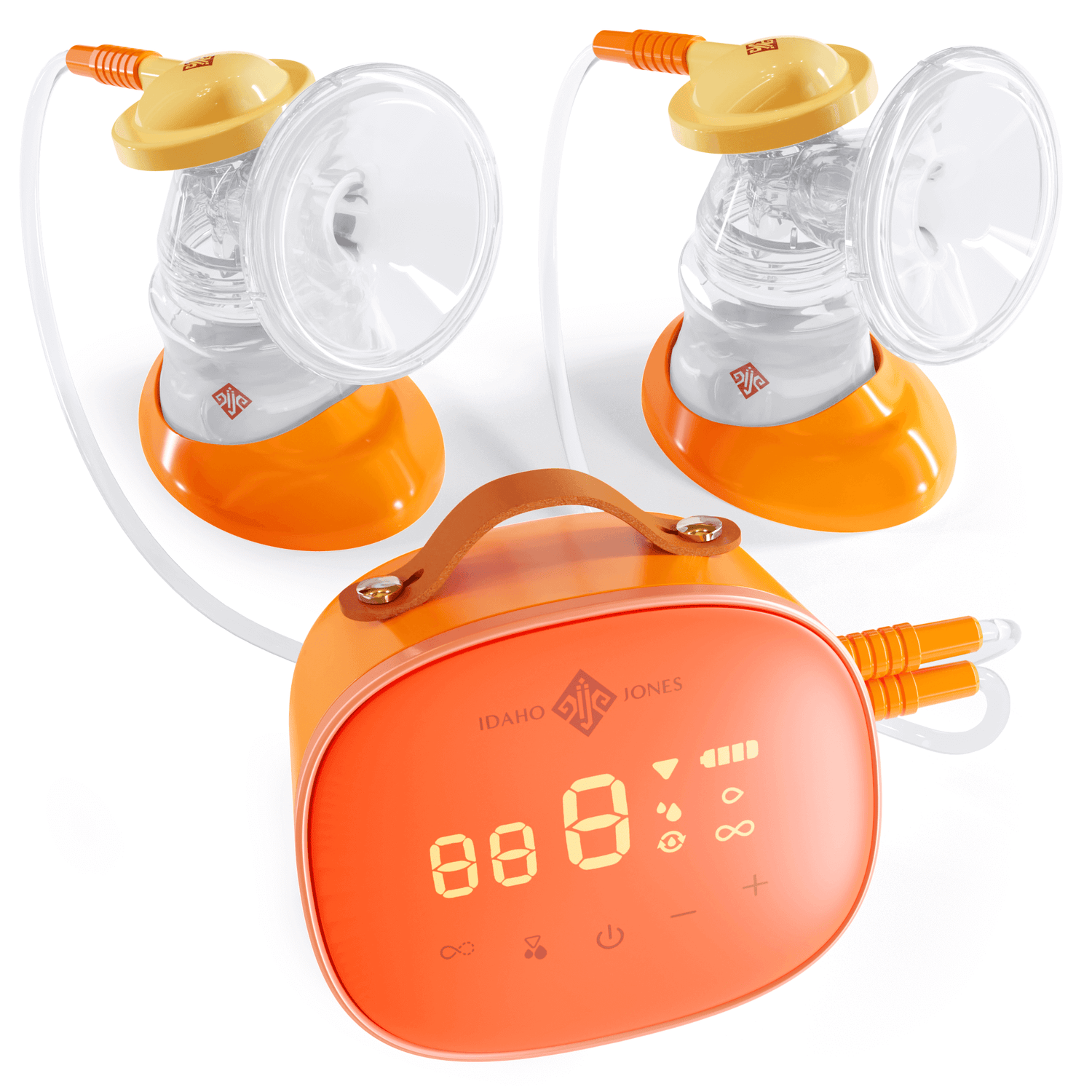
Cracked Nipples From Breastfeeding
Share
First of all—ouch! We feel for you. Cracked nipples don’t have to be part of the breastfeeding experience, but sometimes they happen. Cracked nipples are a painful injury that need to be taken seriously and treated properly so that they heal up and don’t happen again. Let’s take a look at prevention, causes and treatment, and how to keep that baby fed while you are recovering. Read on for relief!
While it is possible that cracked nipples could result from a one-off incident such as a teething related bite from an older baby, it’s far more likely that the damage occurred over time from sub-optimal position and latch, or a yeast infection of the nipple (thrush). In fact, the two can go together, with minor abrasions to the nipple from shallow latch technique becoming host to yeast, which then proliferates and blossoms into painful cracks. Yikes! Even thinking about it can feel toe-curling. What’s a breastfeeding mother to do?
If you find yourself with cracked, damaged nipples, don’t despair. Go ahead and have a good cry if you need to, but know that there is help and relief available. Cracks will heal. This does not need to be the end of your breastfeeding journey.
First things first.
While figuring out the cause of the damage is essential to putting a treatment plan in place, the first thing to determine is if you are able to continue feeding the baby at the breast or if you need to temporarily interrupt breastfeeding and pump your milk. If only one nipple is cracked you could continue to breastfeed on the intact side while pumping your milk on the painful side. The breast pump is less likely to further injure the nipple or cause pain at this time, provided the flanges fit properly and do not rub against the nipple (they should not). It’s important to keep removing milk from the affected breast during this time, both to protect your milk supply and to prevent further infection (mastitis) that can happen from sudden weaning.
If you do not have access to a quality breast pump that fits properly, your best bet is to continue putting your baby to breast. Bear in mind the sharpest pain will be at the initial latch and will probably only last a few seconds before abating.
Here are a few tips to help see you through:
- Feed on the least sore side first. Your baby will likely be gentler on the second breast.
- Use a different position than you’ve become accustomed to using. Get creative. Take a look at our blog post on various nursing positions for you to try.
- Ice your nipple for a few seconds before latch to take the edge off the pain.
- Ibuprofen twenty minutes or so before latching can also help take the edge off pain and is compatible with breastfeeding.
- If you need to take the baby off the breast, break the “seal” by inserting a finger in the corner of the baby’s mouth and gently pulling back her cheek first.
- If your baby wants to comfort nurse at the end of the feed, put him back on the least sore breast for now or let your partner or another helper tend to his needs.
Okay, the baby’s fed. Phew! It’s time for some nipple care.
- Immediately after breastfeeding, bathe your nipples in normal saline solution. You’re hearing salt and probably cringing, but do not worry—normal saline solution is gentle and will not sting. Normal saline solution will prevent infection and speed healing. Mix ½ tsp salt in 8oz of warm water. Hold a burp cloth under your breast while you dribble solution from a squirt bottle onto your nipple, making sure to apply it to the cracks. Do this after every breastfeed or pumping session until the cracks are gone. Air dry or pat dry with a clean, soft cloth.
- Moist wound healing. It’s not what you think—it’s not about keeping your breasts wet. It’s about creating a barrier between the wound and the world to maintain internal moisture and promote healing. You can use a pure lanolin nipple ointment as the barrier or try hydrogel pads. Both can be quite soothing and are hypoallergenic for mom and baby.
- Your own breastmilk can help promote healing. If you leak a little between feeds rub it onto your nipples (with clean fingers) and allow to air dry.
- Skip the nursing pads for now. If you must wear them, be sure to change them frequently.
- Try going topless between feeds and exposing your nipples to room air.
- It is okay (and helpful) to wash cracked nipples with mild soap once a day in the shower.
- If wearing a bra is painful, try using breast shells to keep the fabric off the crack.
When to get help?
Probably now!
There is a ton of quality information out there to see you over hurdles like cracked nipples, but sometimes nothing beats a consultation with an expert, and this is likely one of those times. Consider a visit with a lactation consultant, or a qualified breastfeeding helper like a La Leche League leader, or a visit to your OB-GYN. Eyes on right now can’t hurt and can help you speed healing and get to the crux of the issue.
The crux of the issue? Do you mean there’s more to this?
Yes! We do! So far we’ve reviewed some techniques for minimizing pain and some basic nipple wound care, but we haven’t begun to sort out and adjust for the cause of the nipple damage in the first place. Breastfeeding is not supposed to hurt or cause injury, so what’s going on?
There are two general places to look:
- Technique related problems
- Anatomical considerations. (These can be either baby-sided or mom-sided.)
We’re going to look at both of these types of situations, but before we do here is an important caveat:
Some nipple wounds should be treated with prescription medications.
When infection is present, either fungal or bacterial, the self-care described above is soothing and promotes healing, but should be augmented with targeted topicals or even oral medications.
Is the crack infected? Certainly oozing or greenish or yellow coloration to an open crack warrant a visit to the doctor, but short of that how can you tell? It’s not always clear. The important thing is that your self-care efforts are moving the needle. If your pain is not improving and your nipples are not showing signs of healing within a day or so of self-care we urge you to seek help.
Technique related problems
Breastfeeding is not nipple feeding. To feed effectively, baby opens wide and latches deeply onto the breast, with the nipple way back in the mouth, making gentle, painless contact with the soft palate. Baby forms a seal around the breast and her tongue and jaw action draws the milk from deep inside the breast, within the milk making tissue, through the ducts, and into her mouth. In most cases, breastfeeding is a mild sensation for the mother which many find pleasant, pleasurable, and enjoyable.
When the baby does not have a deep latch, the nipple is clamped up against the hard palate at the front of the mouth and the baby’s tongue and jaw action causes painful friction to sensitive nipple tissue. Over time, the friction and pressure on the nipple from a shallow latch leads to abrasions.
Abrasions sting but are bearable for most, but if the problem isn’t corrected promptly, the minor abrasions can worsen by continued friction or become host to yeast or bacteria which worsens the pain and the wound.
Here is a great post on how to achieve a deep, comfortable latch.
Anatomical considerations, baby-sided
In a word, tongue-tie. This is where baby’s oral anatomy, specifically a tight lingual frenulum, restricts her tongue movement, causing painful friction on the nipple and often resulting in ineffective milk removal. If you suspect tongue-tie, seek help from a lactation consultant or your baby’s pediatrician. In most cases, tongue ties can be released quickly and painlessly and result in notable pain relief for the mom and a more satisfied and less fussy/frustrated little feeder.
But there can be other baby-sided causes. Torticollis, for example, a temporary condition caused by the baby’s positioning in the womb prior to birth, can impede baby’s ability to latch comfortably and effectively onto the breast. A lactation consultant can help you with positioning ideas for feeding a baby with torticollis. Your baby’s pediatrician will have further information and resources, as well.
Anatomical considerations, mom-sided
Anatomical issues on the mom’s side could be something as simple as large nipples. (Lactation consultants sometimes jokingly refer to this as an “oral-boobular disproportion.”) This is something that improves over time as the baby grows.

A tool. But use with caution.
We would be remiss if we didn’t mention that some moms with cracked nipples can benefit from a properly fitted nipple shield. A nipple shield is a soft, sombrero-shaped, silicone device with holes in it to allow milk transfer, that the mom wears over her nipple when breastfeeding. You can pick up a nipple shield at your local pharmacy. A nipple shield can provide temporary relief from pain and keep mom and baby breastfeeding during the healing process. Nipple shields can sometimes slow down milk transfer and some moms get frustrated to find their baby has become dependent on the shield and won’t breastfeed without it, so use this tool with caution.
Wishing you a speedy recovery from nipple damage, and much joy along your breastfeeding journey!

